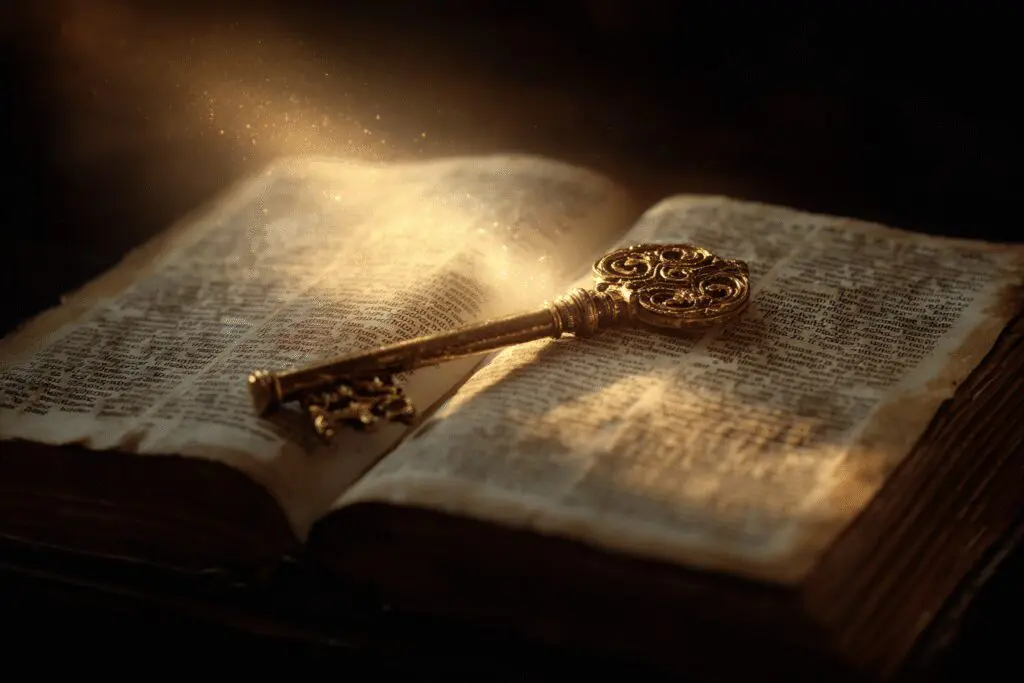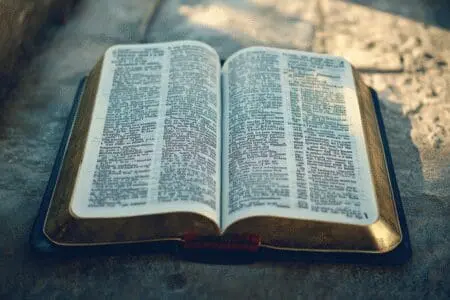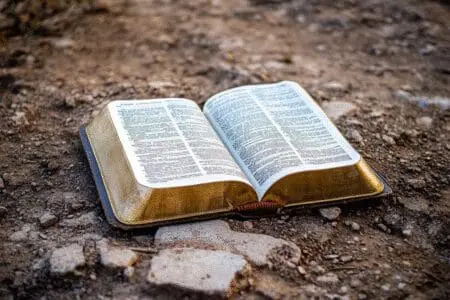For most of my life, the Bible was just a heavy book on a hotel nightstand or something my grandma quoted from. It felt ancient, impenetrable, and honestly, a little irrelevant. It seemed like a collection of fairy tales, a list of arbitrary rules, and stories so old they couldn’t possibly have anything to do with my life. I had a thousand questions, but they all boiled down to one big one: What is the truth about the Bible? Is it a historically accurate document, a book of myths, or something else entirely?
I’m not a pastor or a scholar. I’m just a guy in my early thirties who got tired of not knowing. I wanted to move past the secondhand opinions and the cultural noise to figure out for myself what was fact and what was fiction. This wasn’t about finding a “gotcha” to debunk it or blindly accepting everything. It was about honestly trying to understand this incredibly influential book on its own terms. So, I started digging, and what I found wasn’t a simple, neat answer. It was something far more interesting.
More in Bible Category
Is the New Living Translation Bible Accurate
Key Takeaways
Before we dive in, here’s the short version of what I’ve learned on my journey:
- The Bible isn’t one book. It’s a library of 66 different books, written by dozens of authors over 1,500 years in different languages and styles. You can’t read it all the same way.
- We don’t have the “originals.” The first manuscripts written by the authors don’t exist anymore. What we have are copies of copies. But the discovery of ancient manuscripts has shown them to be incredibly consistent over time.
- Translation changes things. The version you read—whether it’s the poetic old King James or a modern, easy-to-read version—shapes how you understand the text. They have different goals.
- History and archaeology can ground the stories in reality. Many places, people, and events mentioned in the Bible have been confirmed by external evidence, showing it’s not set in a fantasy world. But that doesn’t “prove” the miracles.
- Context is everything. Reading the Bible with 21st-century eyes is a recipe for confusion. Understanding who wrote it, why, and to whom is the key to unlocking its meaning.
- It was never meant to be a science or history textbook. Trying to make Genesis a science lesson or Exodus a modern historical report is asking the wrong questions of the text.
- It’s okay to have doubts. The book itself is full of people questioning, wrestling, and doubting. Approaching it with honest questions is part of the process.
But Honestly, Where Do You Even Start?
My first real attempt to read the Bible was a disaster. I figured, “It’s a book, I’ll start on page one.” I opened up Genesis, which was interesting enough, but by the time I hit the dense laws and genealogies in Leviticus and Numbers, my eyes glazed over. It felt like trying to read a car manual and a legal textbook at the same time. I gave up.
It felt like this single, monolithic, intimidating block of text. If you couldn’t get through all of it, in order, you failed. That perception is probably the biggest barrier for most people.
It’s Not a Book, It’s a Library
The first major “a-ha” moment for me was realizing the Bible isn’t a book. It’s a library. It’s a collection—a canon—of 66 separate documents. These were written by more than 40 different authors over a span of about 1,500 years, on three different continents, in three different languages (Hebrew, Aramaic, and Greek).
Imagine walking into a library and thinking you have to read every single book from the first shelf to the last in perfect order. You’d never do that. You’d look for the history section, or maybe poetry, or biographies. The Bible is the same. It contains all of these genres:
- Law: The first five books of the Old Testament.
- History: Books like Joshua, Kings, and Chronicles that narrate the story of the Israelites.
- Poetry: Psalms (which are basically song lyrics), Proverbs, and Song of Solomon.
- Prophecy: Books by figures like Isaiah and Jeremiah addressing the political and spiritual state of Israel.
- Gospels: Four different biographical accounts of the life of Jesus.
- Epistles: Personal letters written by early church leaders like Paul and Peter to new Christian communities.
- Apocalyptic Literature: The wild, symbolic, and often-misunderstood book of Revelation.
Once I understood this, the pressure was off. I didn’t have to read it like a novel. I could start with a Gospel, like Mark, which is short and action-packed. Or I could read some of the practical wisdom in Proverbs. It became approachable.
Weren’t These Stories Just Passed Down by Word of Mouth for Ages?
One of my biggest points of skepticism was the whole “oral tradition” thing. In our modern world, that sounds like a game of telephone. I tell you a story, you tell someone else, and by the tenth person, the story is completely different. It felt like a fatal flaw. How could anything be accurate if it was just talked about for generations before being written down?
But I learned that ancient, pre-literate cultures treated oral tradition very differently than we do. Memory was a highly trained skill. Important stories—the stories that defined a people’s identity, laws, and faith—were not casual gossip. They were passed down with extreme care and precision, often through poetic structures, songs, and communal recitation that made them easier to memorize accurately. It wasn’t a game of telephone; it was more like the sworn duty of a town crier to get the king’s proclamation exactly right, word for word.
So, What About the “Original” Bible?
This leads to the next logical question. Fine, maybe the oral tradition was more reliable than I thought, but what about the written text? Where is the original copy of the Gospel of John, penned by the author himself?
The short answer is, it doesn’t exist. We don’t have the original “autographs” for any book of the Bible. What we have are thousands upon thousands of manuscript copies, made by scribes over the centuries. For a long time, the oldest copies of the Hebrew Bible (the Old Testament) we had dated to about the 10th century AD. That’s a thousand-year gap from when the last books were completed. A lot could have gone wrong in that time.
Then, in 1947, a shepherd boy stumbled into a cave and found a collection of jars containing the Dead Sea Scrolls. It was the archaeological find of the century. These scrolls contained manuscripts of almost every book of the Old Testament, and they were a full 1,000 years older than the copies we had been relying on. It was the ultimate test. Had the text changed significantly over a millennium of copying?
The answer was a resounding no. As scholars compared the scrolls with the 10th-century texts, they found that the manuscripts were astonishingly, almost identical. There were minor variations, like spelling differences (think “color” vs. “colour”), but the message was the same. The scribal tradition had been unbelievably precise. You can even view these scrolls online today through the Israel Museum’s Digital Dead Sea Scrolls project and see for yourself.
If It’s Been Copied and Translated So Many Times, How Can We Trust It?
This was another huge hurdle for me. Even if the copying was accurate in the original languages, we’re reading translations. Every time you translate, don’t you lose something? Don’t you introduce someone’s bias? This is a completely valid concern.
The Scribe’s Obsessive Attention to Detail
Before we even get to translation, it’s worth understanding the mindset of the people doing the copying. For ancient Jewish scribes, copying the scriptures was a sacred act. These weren’t just bored monks in a back room. There were rigorous rules they had to follow.
They had to use a specific kind of ink and write on skins from clean animals. Before writing the name of God, they had to wipe their pen and wash their whole body. They counted every letter and every word of every page and compared it to the original. If a single letter was misshapen, or if two letters touched, the entire page was destroyed and they had to start over. This wasn’t just a job; it was an act of worship. This meticulous process is a huge part of why the Dead Sea Scrolls matched the much later texts so well.
But What About Translations? Doesn’t That Change Everything?
Okay, so the Hebrew and Greek texts are reliable. But I don’t read Hebrew or Greek. I’m relying on English translators. My first exposure to the Bible was my grandmother’s King James Version. It’s beautiful, full of “thee’s” and “thou’s,” but reading it felt like trying to read Shakespeare. It was work. Later, a friend showed me a modern translation, the New Living Translation (NLT), and it was like a lightbulb went on. It was in plain, normal English I could actually understand.
But it made me wonder: which one is the “real” Bible?
I learned there are two main philosophies when it comes to translation:
- Formal Equivalence (Word-for-Word): This approach tries to match the original text as literally as possible. It preserves the sentence structure and grammar of the original Hebrew or Greek. The King James Version (KJV), New American Standard Bible (NASB), and English Standard Version (ESV) are in this camp. The upside is precision. The downside is that they can be clunky and hard to read, because Hebrew and English grammar are very different.
- Dynamic Equivalence (Thought-for-Thought): This approach focuses on translating the meaning or the original thought, rather than the exact words. It asks, “How would a modern English speaker express this same idea?” The New Living Translation (NLT) and The Message (MSG) are examples of this. The upside is readability. The downside is that it involves more interpretation from the translators.
Think of it like this: A word-for-word translation is like a literal subtitle on a foreign film. A thought-for-thought translation is like a professional dub, where the goal is to make the dialogue sound natural to the new audience. Neither is inherently “better,” they just have different goals. The best approach is often to use both—one for close study and one for general reading.
Does History or Archeology Actually Back Any of This Up?
I’m a practical person. I wanted to know if this book, which claims to be rooted in history, actually has any connection to the real world. Were these people and places real? Or was it all set in a sort of religious “Middle-earth”?
For years, scholars doubted the existence of figures like King David, claiming he was a mythological figure like King Arthur. Then, in 1993, archaeologists discovered the Tel Dan Stele, a stone monument from the 9th century BC that explicitly mentions the “House of David.” Suddenly, David stepped out of myth and into history.
The same thing has happened over and over.
- The Pilate Stone, discovered in 1961, is a carved inscription that confirms Pontius Pilate, the Roman governor who oversaw Jesus’s crucifixion, was a real historical figure.
- Hezekiah’s Tunnel in Jerusalem, a massive engineering feat described in the Bible, is a real place you can walk through today.
- Archaeologists have found the Pool of Siloam, the very place where the Gospel of John says Jesus healed a blind man.
These finds don’t prove that Jesus healed the man or that David was a “man after God’s own heart.” They don’t prove the miracles. What they do is provide external, non-biblical corroboration that the biblical narratives are grounded in real history, with real people, in real places. The writers weren’t just making it all up.
What About the Big Stuff? Like the Exodus?
At the same time, it’s important to be honest about what archaeology hasn’t found. There is currently no direct archaeological evidence for the biblical story of the Exodus—two million Israelites wandering in the Sinai desert for 40 years. For a skeptic, this can feel like a knockout blow.
But this is where we have to again ask about the purpose of the text. Was the author of Exodus trying to write a 21st-century historical account that could be verified by digging in the sand thousands of years later? Or were they trying to write a theological foundation story for the nation of Israel? Their goal was to communicate a profound truth: our God is a God who rescues His people from slavery. The historical details served that theological purpose. Demanding a level of scientific proof that the original author never intended to provide is asking the wrong question of the text.
So, Is It All Literal, or Is Some of It Metaphor?
This is the big one. This is where so many people get stuck. Do you have to believe the earth was created in six, 24-hour days? That Noah fit every species of animal on a boat? For a long time, I thought that being a person of faith meant turning off your brain and accepting the scientifically impossible.
My whole perspective changed when someone encouraged me to try reading with ancient eyes, not modern ones. An ancient Israelite reading the Genesis 1 creation account was not asking, “Is this a scientifically precise timeline?” Science, as we know it, didn’t exist. They were surrounded by other cultures whose creation stories involved violent, chaotic gods battling sea monsters to create the world.
In that context, Genesis 1 was a radical, revolutionary declaration. It says that the universe was created not by chaos and war, but by a single, powerful, orderly God who spoke it into existence. It says that the sun, moon, and stars aren’t deities to be worshiped, but are simply “lights” created by that God. And it says that humanity is not an accidental byproduct of a divine war, but the intentional, cherished pinnacle of that creation.
It’s an earth-shattering theological statement about the nature of God and humanity. It was never intended to be a science textbook. To read it as one is to completely miss the point. This was a game-changer for me. I realized I didn’t have to choose between science and the Bible. They were asking different questions and trying to achieve different things.
Okay, But Is Any of This Relevant to My Life?
After all this—the history, the translations, the context—it comes down to a final question: So what? What does a collection of ancient documents have to do with my job, my relationships, my anxieties, my life today?
I used to see the Bible as a rulebook full of outdated prohibitions. And sure, there are laws in there. But that’s not the heart of it. When I actually started reading the stories, I didn’t find perfect, plastic saints. I found real, messy, flawed human beings.
I found Jacob, a deceiver and a cheat who literally wrestles with God all night and walks away with a limp.
These aren’t bedtime stories. They are raw, honest portrayals of the human condition. I saw my own struggles in their stories. I saw my own mix of faith and doubt, my own capacity for both great loyalty and great failure. The Bible stopped being a book about ancient people and became a book about people. About me.
The “truth” about the Bible, as I’ve come to see it, isn’t a simple checklist of historical facts you have to agree with. The truth is found in the profound wisdom of Proverbs, the gut-wrenching honesty of the Psalms, and the world-altering story of a God who pursues messy, broken people.
My journey isn’t over. I still have questions. I still have doubts. But I’m no longer intimidated by this ancient library. It’s not a rulebook to be feared or a history text to be debunked. It’s an invitation to a conversation, a story to be wrestled with, and a lifelong journey of discovery. And that is a truth I can build on.
Frequently Asked Questions – What Is the Truth About the Bible

Does the Bible remain relevant today despite being an ancient text?
Yes, the Bible remains relevant because its themes of love, justice, and human experience continue to address fundamental human needs and questions, influencing art, law, and social justice even today.
Are the differences in the Gospels a sign of inaccuracies?
The differences in the Gospels reflect the individual perspectives and audiences of the writers, similar to eyewitness accounts of a car crash, which enrich the narrative rather than undermine its truth.
Do contradictions in the Bible disprove its truth?
Contradictions in the Bible can often be explained by understanding different perspectives and the way ancient writers recorded events, such as differing accounts of Judas’s death, which can be seen as complementary rather than contradictory.
How do we know that the Bible has not been significantly altered over time?
We know the Bible has not been significantly altered because there are over 5,800 ancient copies of the New Testament, which are mostly consistent, showing that the core message has been preserved despite minor copyist errors.
Is the Bible considered a reliable historical document?
The Bible is considered a reliable historical document because many archaeological discoveries, such as the Stone of David and proof of figures like Pontius Pilate, match the biblical accounts, demonstrating that it is based on real history.




